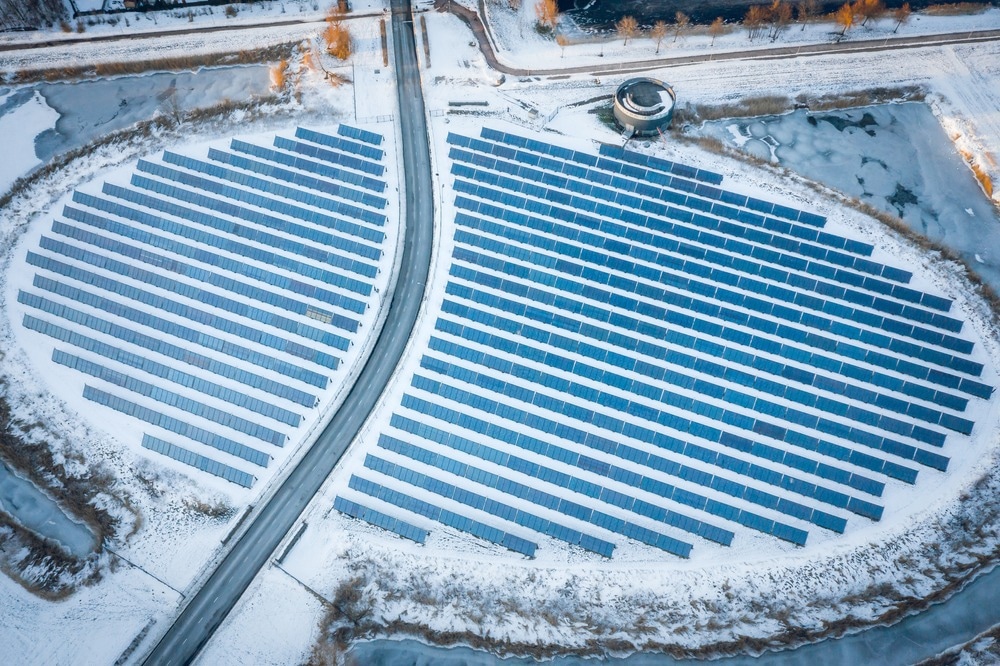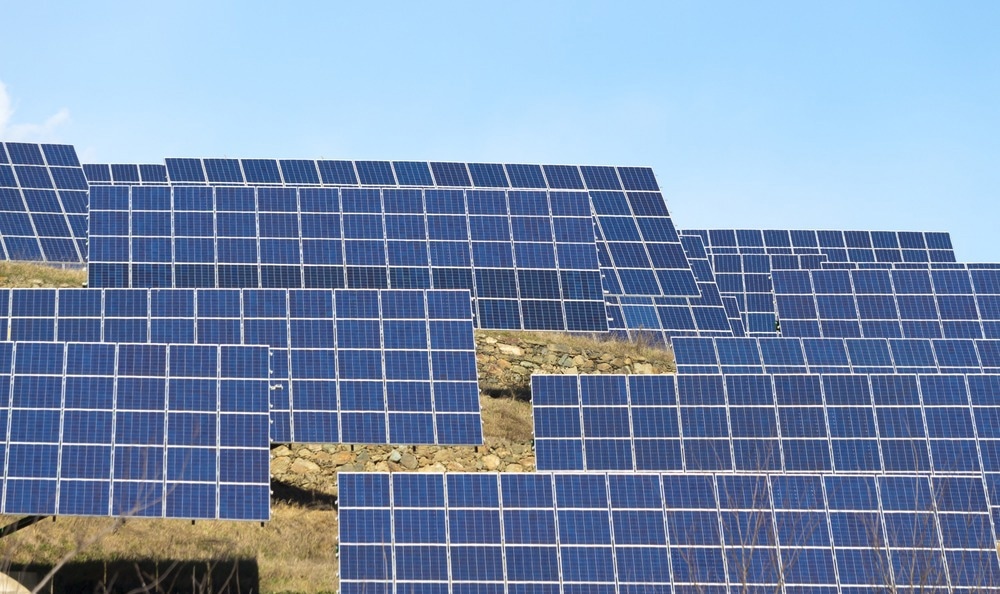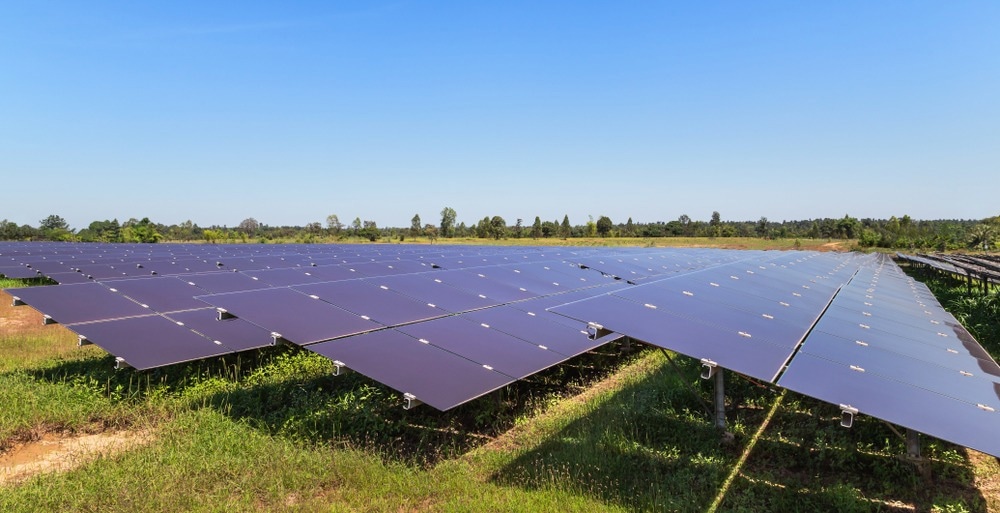Photovoltaic (PV) cells are integral to modern renewable energy systems, providing clean and sustainable energy. Their widespread adoption has been driven by advancements in new materials, increased efficiency, and reduced costs. This article provides an overview of PV cells, including their types, applications, adoption challenges, and recent advancements shaping the future of solar energy.

Image Credit: Pavlo Glazkov/Shutterstock.com
What are PV Cells and How Do They Generate Electricity?
Photovoltaic cells are energy-harvesting devices that convert solar energy into usable electricity through the photovoltaic effect. These cells consist of n-type semiconductors, which have excess electrons, and p-type semiconductors, which contain an excess of positive charges known as holes.
These semiconductors form a p-n junction where holes from the p-region and electrons from the n-region move across the junction, creating a diffusion current. Simultaneously, an electric field generated by fixed ions at the junction opposes this flow, leading to a drift current. At equilibrium, the diffusion and drift currents balance each other, establishing a potential barrier at the p-n junction.
When photons from sunlight hit the cell, their energy frees electrons, creating hole-electron pairs. The electric field drives these carriers through the junction, and when an external load is connected, this movement produces electric current and voltage across the cell.1
Types and Generations of PV Cells
PV cells have evolved across several generations, each incorporating advanced materials that improve efficiency, reduce costs, and expand applicability.
First generation: Thick crystalline silicon PV cells

Image Credit: caifas/Shutterstock.com
The first generation of photovoltaic cells primarily consists of thick crystalline silicon materials, including monocrystalline and polycrystalline silicon, and single junction III-V compounds like Gallium arsenide (GaAs).
Monocrystalline silicon cells typically achieve 15-24% efficiencies, while polycrystalline silicon cells exhibit 10-18% efficiencies. Due to their high efficiency and longevity, this generation dominates the current PV market, representing over 80% of global installed solar capacity.
Second generation: Thin-film PVs

Image Credit: Soonthorn Wongsaita/Shutterstock.com
The second generation of PV cells includes thin-film cells made up of cadmium telluride (CdTe), copper indium gallium selenide (CIGS), and amorphous silicon (a-Si).
CdTe solar cells can achieve 15-16% efficiencies, while CIGS cells can reach around 20%, and a-Si cells generally fall between 5-12%. These cells are designed for lower-cost production and improved flexibility, making them suitable for various applications.
Third generation: Emerging PV technologies
The third generation of solar cells includes advanced technologies such as perovskite, organic, dye-sensitized, quantum dot, and multi-junction cells. Perovskite solar cells are noted for their efficiency of 21%, while multi-junction cells can exceed 36%.
These emerging technologies aim to balance cost and efficiency, often incorporating new materials and designs to enhance performance and expand applications.2
Applications of PV Cells
Commercial and residential solar systems
PV systems are increasingly generating clean electricity globally, with PV panels integrated into building materials like roofing, glass, and siding. These systems store electricity in batteries for nighttime use, powering homes, schools, clinics, and small businesses while providing a sustainable alternative to traditional energy sources and reducing greenhouse gas emissions.
In addition, this integration reduces cooling loads by providing shade in summer and allows natural light in winter, demonstrating significant energy-saving potential.
Urban and infrastructure applications
In urban environments, PV systems are increasingly deployed for street lighting, recreational area illumination, and powering highway signs, highlighting their versatility in infrastructure applications. They also support remote monitoring equipment and small commercial ventures, improving urban infrastructure's functionality, security, and sustainability.
Water and energy management in remote areas
PV technology excels in remote locations, providing greater efficiency than diesel alternatives for water pumping and energy management and lower operational and maintenance costs.
In developing regions, PV systems can power village water supplies by pumping water into storage tanks during daylight for gravity-fed distribution. They are also employed in desalination systems, where solar-powered plants process up to 5.8 m³ of brine daily to produce fresh water.
Transportation and hydrogen production
PV technology is advancing in transportation by providing auxiliary power for vehicles like cars and boats, including PV cells integrated into automobile sunroofs. Electricity from PV systems can be used to produce green hydrogen, a renewable fuel easily stored and transported globally.
Space applications
In space, PV technology utilizes lightweight designs for satellite power sources, employing large microwave towers to transmit energy to Earth. It also enables nighttime power generation on terrestrial bodies by harnessing reflected light from nearby planetary objects through advanced low-intensity low-illumination (LILT) solar cell technology.3,4
Challenges of Widespread Adoption of PV Cells
Despite their promise, PV cells face several challenges that hinder widespread adoption.
Efficiency limits
The theoretical efficiency of silicon-based PV cells is capped at approximately 33% by the Shockley-Queisser limit, while most commercial cells achieve only 15% to 24%.
Material limitations and toxicity
Second-generation PV cells, such as CdTe cells, pose environmental and safety concerns due to material toxicity and the limited availability of rare components like tellurium.
Degradation and longevity
PV cells experience degradation from environmental factors like moisture and temperature fluctuations, leading to a gradual decline in efficiency over their typical 25-year lifespan.
Cost and economic barriers
Despite a significant reduction in PV technology costs, high initial installation expenses remain a barrier, particularly in areas without financial incentives, while advanced systems such as multi-junction and perovskite cells incur higher costs due to complex materials and production processes.4,5
Recent Research and Developments in Photovoltaic Technology
PV technology is rapidly evolving, with researchers and companies pushing the boundaries of efficiency, cost-effectiveness, and applicability.
Recently, LONGi achieved a record photovoltaic efficiency of 34.6%, with its silicon-perovskite tandem solar cells surpassing the previous 33.9% record and nearing the 43% theoretical limit. They accomplished this by optimizing deposition processes and incorporating high-efficiency materials on commercial Czochralski (CZ) silicon wafer substrates, leading to a 0.7% efficiency improvement in just five months.6
Kaunas University of Technology researchers synthesized thiazol[5,4-d]thiazole derivatives to enhance indoor photovoltaic cells, achieving power conversion efficiencies of 37% under 3000 K LED illumination. These perovskite solar cells can generate electricity in low-light conditions, making them suitable for powering Internet of Things (IoT) devices and expanding solar energy applications in indoor environments.7
Oxford University's researchers recently developed a flexible thin-film perovskite material just over one micron thick for solar technology, achieving over 27% power conversion efficiency. This ultra-thin material can be applied to everyday objects, expanding solar energy generation while reducing reliance on traditional silicon panels and lowering costs.8
The Future of Photovoltaic Cells
Photovoltaic cells are advancing renewable energy technology through improved materials and manufacturing, enhancing efficiency and reducing costs. Despite challenges such as efficiency limits and material toxicity, ongoing research offers promising solutions, positioning PV technology as vital for meeting global energy demands, especially in off-grid and remote areas.
References and Further Reading
- Antonio, J., María, A., & Peña Capilla, R. (2018). Materials for Photovoltaics: State of Art and Recent Developments. International Journal of Molecular Sciences, 20(4), 976. https://doi.org/10.3390/ijms20040976
- Pastuszak, J., & Wegierek, P. (2021). Photovoltaic Cell Generations and Current Research Directions for Their Development. Materials, 15(16), 5542. https://doi.org/10.3390/ma15165542
- NREL. (2024). Photovoltaic Applications. [Online]. Available from: https://www.nrel.gov/pv/applications.html
- Rathore, N., Panwar, N. L., Yettou, F., & Gama, A. (2021). A comprehensive review of different types of solar photovoltaic cells and their applications. International Journal of Ambient Energy, 42(10), 1200-1217. https://doi.org/10.1080/01430750.2019.1592774
- University of Calgary. (2024). Photovoltaic cell. [Online]. Available from: https://energyeducation.ca/encyclopedia/Photovoltaic_cell
- Longi. (2024). 34.6%! Record-breaker LONGi Once Again Sets a New World Efficiency for Silicon-perovskite Tandem Solar Cells. [Online]. Available from: https://www.longi.com/en/news/2024-snec-silicon-perovskite-tandem-solar-cells-new-world-efficiency/
- Dabuliene, A., Shi, Z. E., Leitonas, K., Lung, C. Y., Volyniuk, D., Kaur, K., ... & Grazulevicius, J. V. (2024). Enhancement of Efficiency of Perovskite Solar Cells with Hole-Selective Layers of Rationally Designed Thiazolo [5, 4-d] thiazole Derivatives. ACS Applied Materials & Interfaces. https://doi.org/10.1021/acsami.4c04105
- University of Oxford. (2024). Solar energy breakthrough could reduce need for solar farms. https://www.ox.ac.uk/news/2024-08-09-solar-energy-breakthrough-could-reduce-need-solar-farms
Disclaimer: The views expressed here are those of the author expressed in their private capacity and do not necessarily represent the views of AZoM.com Limited T/A AZoNetwork the owner and operator of this website. This disclaimer forms part of the Terms and conditions of use of this website.